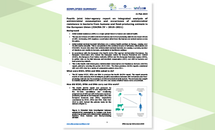Simplified summary: JIACRA IV, 2019-2021
This is a summary of the fourth joint inter-agency report on integrated analysis of antimicrobial consumption and occurrence of antimicrobial resistance in bacteria from humans and food-producing animals in the European Union (JIACRA IV – 2019–2021).
Executive Summary
Continued and coordinated action is needed to achieve, by 2030, a 20% reduction of AMC in humans (compared to 2019 levels) and a 50% reduction in food-producing animals (compared to 2018 levels), as recommended by the Council of the European Union and as set in the Farm-to-Fork strategy, respectively, including training of health and veterinary professionals.
Specific efforts should be undertaken to reduce and limit AMC overall both in human and animal sectors, as decreases in overall AMC have been associated with decreases in overall AMR. Particular attention should be also paid to limiting the use of the most important antimicrobials (as defined by EMA's Antimicrobial Advice Ad Hoc Expert Group) in human medicine.
Increased focus on preventive measures and infection control is crucial to reduce the need for antimicrobial treatments and prevent the spread of AMR.
Responsible and prudent use of antimicrobials should be ensured, and efforts should be made to improve the availability, accessibility and compliance to diagnostic testing and treatment guidelines.
Complementary data should be collected for better analysis of the relationships between AMC and AMR through integrated and harmonised surveillance of AMC and AMR in the human and animal sectors. Data from the environmental sector could also be integrated into the analysis, once available, in a ‘One Health’ approach.
Further targeted studies are needed to investigate and better understand the transmission of antimicrobial-resistant bacteria and AMR genes between animals and humans, as well as the environment.
Download








